Mumbai bid adieu to its iconic red double-decker buses On Friday, September 15, 2023.
Rediff.com's Vaihayasi Pande Daniel, Hitesh Harisinghani and Afsar Dayatar took a ride on the last non AC double-decker bus.
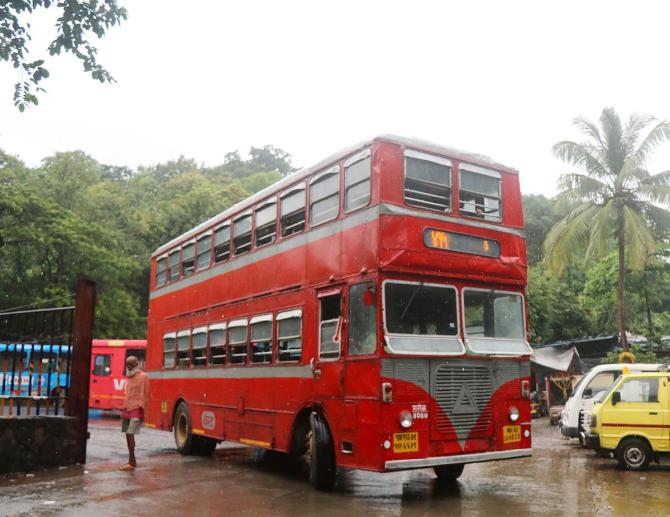
September 14 was a day to remember.
The rumbling red double-decker buses we grew up with in Mumbai were to go off the road on Friday, September 15.
How could one miss a chance to ride them for the last time?
For the sake of nostalgia.
For the sake of history.
For fun.
A casual jaunt on any of last few buses was chalked out with colleagues Hitesh Harisinghani and Afsar Dayatar.
We considered riding 137. Or 132. Else maybe 1 or 133. But were not sure which of these routes still had double-deckers running. And it turned out that 133 and 132 no longer existed and probably many other routes like these.
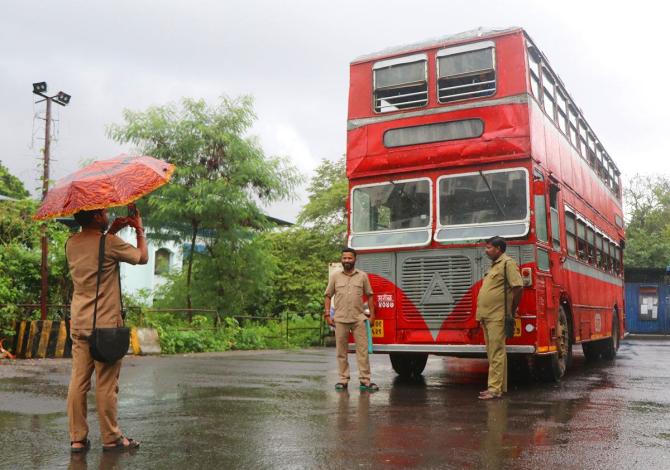
One of the south Mumbai bus depots was the practical choice to begin our adventure.
Many a double decker began its journey from Colaba to traverse the length of the city reaching places as far flung as Anushakti Nagar in Trombay, north east Mumbai.
At the no-longer-as-large Backbay Depot, Cuffe Parade, where a few of the shiny, spanking new electric double-deckers were parked, the khaki-clad BEST staff, swinging their metal ticket boxes, all shook their heads sadly and in Marathi told us, "Hya depot madhun gelya kahi mahinya pasun double decker bus chalat nahit (Double decker buses stopped running from the depot months ago)."
Try Electric House, they suggested.
The deserted and enormous Electric House depot, on Colaba Causeway, had none. Zip. Zilch.
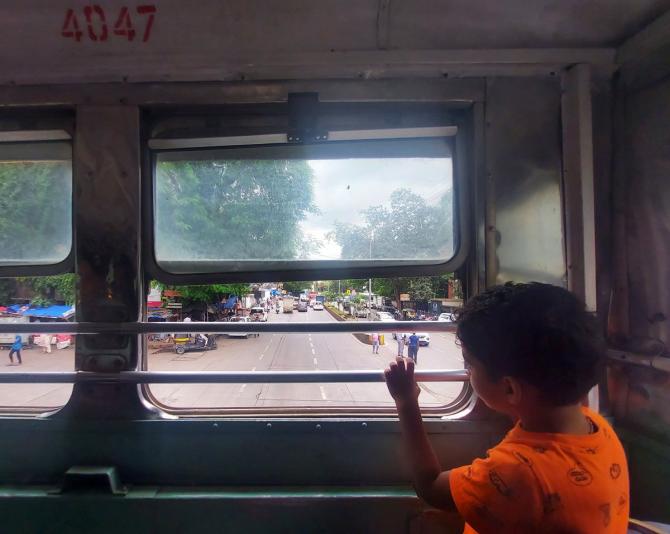
An open-roofed light blue Mumbai Darshan double decker bus was tucked away in the corner waiting for its load of weekend sightseers and party-wallahs (they are apparently to be discontinued too).
A single-storey bus was getting a rubdown via giant brush rollers. And three red electric double-deckers were parked abreast.
The logistics man maintaining the giant log ledger at the entrance to the yard, for bus arrivals and departures, offered, "Double decker buses na scrap karaichi prakriya kahin mahinya puri pasun chalu aahe (Double decker buses have all been scrapped)."
He directed us to the transport officer inside the large depot building.
We were beginning to get fairly disheartened.
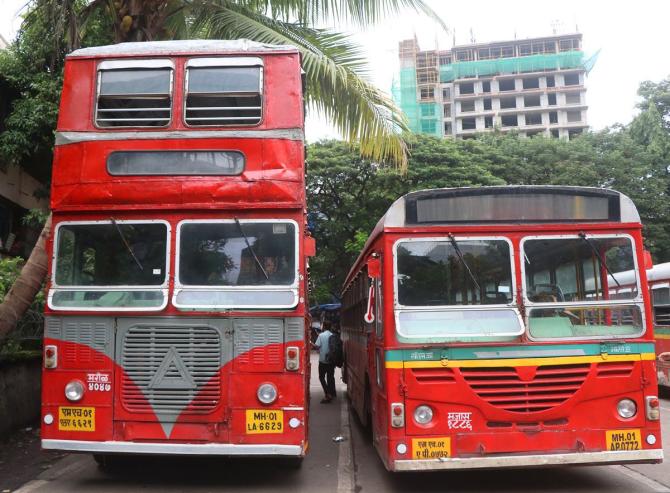
Increasingly, it seemed there was not a single purana zamana double decker to be found. Who knew one of those dearly loved lal buses would prove so incredibly hard to locate! How sad. Was our ride not to be?
What began as a bittersweet, wistful excursion to take our final double decker rides was starting to turn into a nightmare-ish (given the heat) massive vehicle hunt across Bombay for such a species of bus...
What we had simply not realised was that, quietly, silently over the last few years, BEST double decker buses had been just melting away, off the streets of Mumbai, unbeknownst to us all.
The transport officer at Electric House clucked sorrowfully and said: "Kurla", and was persuaded to give us a number at Kurla.
Kurla in north east Mumbai said Marol in north west Mumbai. And that just two buses were running in Marol.
Marol confirmed. One bus. The last apparently. And it was out on its round, schedule details unknown.

Hitesh and Afsar went on ahead, and waited, sweating, on a hot afternoon, for nearly an hour at the Marol depot, fingers crossed, hoping a double decker would actually show up.
Ironic that this bus, that was once a distinctive symbol of the city, one of Mumbai's famous landmarks, albeit a moving landmark, could not be found in the length and breadth of the city, even on its last day (remember almost every postcard of Bombay had a red double-decker on it, Mumbai being one of the few cities in the world to have these buses along with London, Hong Kong, Dhaka, Colombo, Dublin, Sydney, among others).
Sure enough, finally at Marol, one of those grand old beauties rolled or rather trundled in. Message from Hitesh: "Just got into one." Excitement. The last bus had been found.

It was a 415 on its Andheri East station to SEEPZ Village loop, the one solitary grandpapa double among a fleet of several 415s, the balance all sleeker but less exciting regulars.
When I caught up with Hitesh and Afsar at the Western Express Highway Metro bus stop, they were on the top deck of this apparently only surviving bus with a bunch of enthu-cutlet BEST double decker hearties.
The group (there are several Mumbai double decker groups on social media), some of them friends, had taken time off from their regular schedules to ride this 415 in a loop for a couple of hours, reliving fond lifelong memories.
The first row, in front, before the windows, was, of course, occupied. Folks were enjoying their last time, sitting above, in a breezy, open-window bus.
Tales of yore were being traded.
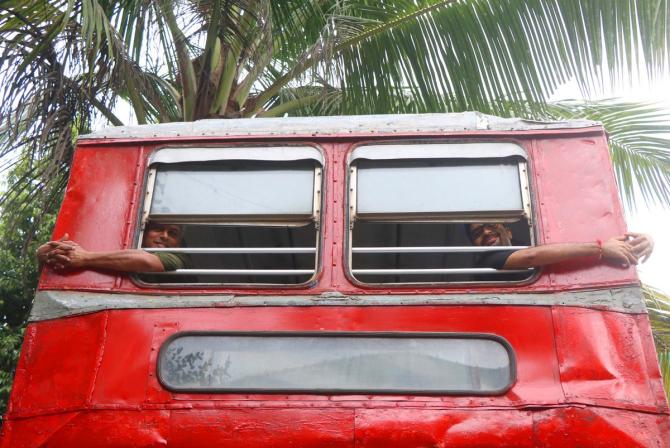
S Arun, who works in tourism and conducts guided walkabouts of the city, and beyond (like Alibag), remembered how as youngsters, while sitting in front, they would chupke se rotate the bus numbers (that are printed on a cloth roll) with their feet, when the conductor wasn't looking, confusing passengers planning to board.
They would invariably get caught and told they would be thrown off the bus if they didn't behave.
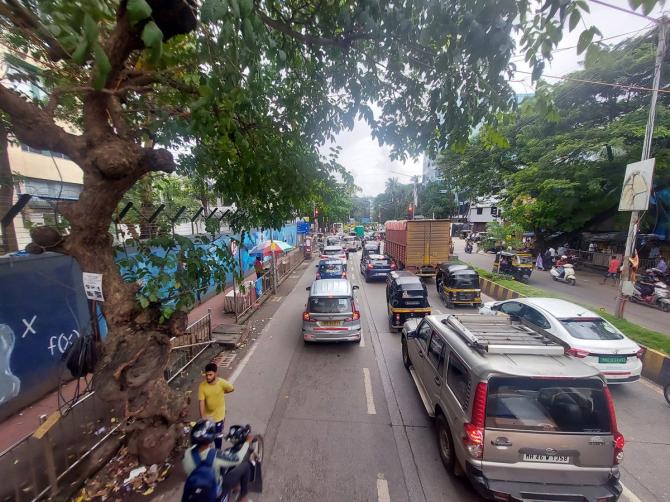
Ankur Jain, who works in IT and is a Bombayphile, in a black t-shirt with a BEST double decker on it and the slogan Double Deckers Are The Best In Town, recalled how some of these buses curved dangerously when they went around the now non-existent Haji Ali circle at the beginning of south central Mumbai. He was enthusiastically shooting all varieties of shots for posterity, including of Arun ringing the conductor bell.
There was a mother and child who waited two hours at the Andheri East station to get onto the bus and rode it to the last stop. She wanted her son to experience a double decker ride.
The little boy cutely asked his mom why they were scrapping the buses. His mother told them it was too costly to maintain them anymore. And he digested that, for whatever it was worth.
At the SEEPZ depot, someone got into the driver's seat and posed. Fans also took pics with the entire bus crew.
For all of us -- many, including me, were taking a double d. ride after many years -- there were so many memories to revive and sort of fill into a bottle and cap tightly, to preserve and 'keep fresh like scent' and 'live all over again' when uncorked (that famous line from Daphne Du Maurier's Rebecca).
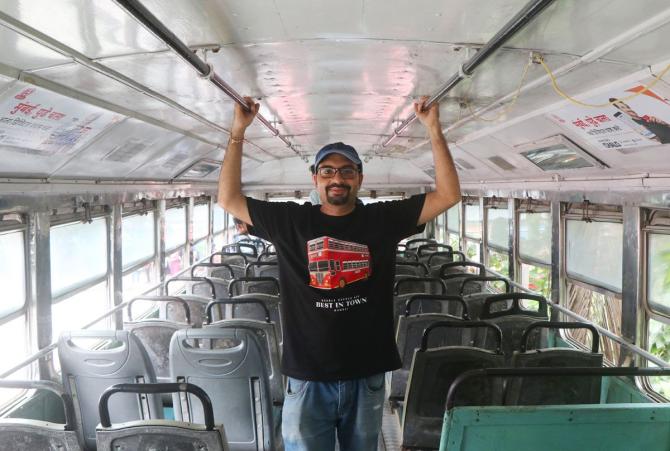
Like the almost musical khat-khat-khat sound the bell on a string would make when the upper-deck conductor pulled it repeatedly to tell the lower-deck conductor or driver below that passengers from on top were still alighting.
Or running up the narrow aluminium stairs -- of course, bypassing the boring auntie-log ka lower deck area, that had a 'Ladies' section, no matter how short your ride -- to find the best seats upstairs to read a novel maybe all the way, through 44 stops, to Bandra Reclamation.
Like the intriguing pomh-pomh the driver's rubber horn emitted, which he used seldom, only in special bada jam situations, preferring the karkash (harsh) and louder sound of the new horn.
Or the pure feel of the wind on your face in those much-in-demand front seats, especially when it went sailing down Marine Drive or Worli Seaface, and other places along the beautiful Arabian Sea.
Like the rhythmic pitter-patter on the roof, that was different on these buses, during torrential Mumbai monsoon days.
Or the slightly alarming noise generated when the bus hit a bunch of tree branches, which was more common on some routes -- 132 while it sped down New Marine Lines.
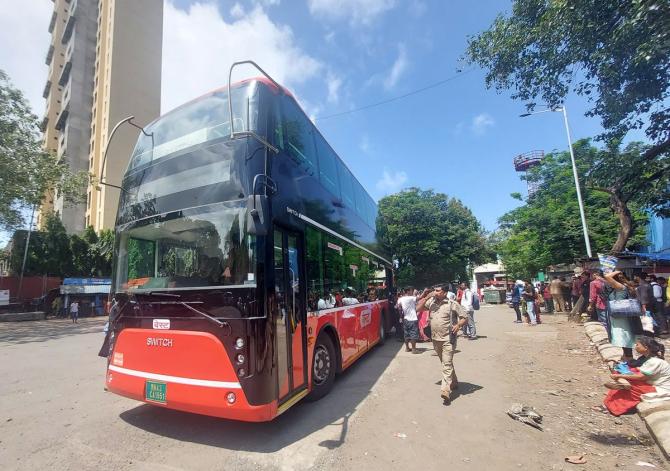
Like the sinking in your heart, you felt when you dropped something and it rolled out of that wraparound side vent at your feet, that all double deckers, had and onto the street, lost forever.
Or dangerously jumping off, running, from the corner of the back door that was only possible on these buses (the reason why Bombay streets are littered with single chappals).
Like the feel of your thin paper ticket which then let you ride for Rs 1.50 from RC Church (the quaint name for St Joseph Church in Navy Nagar) to nearly Vasantrao Naik Chowk, Tardeo.
Such sweet memories. Memories of Bombay that only a bus could gift you, to rest in your mind's eye forever.
After riding Bus 415 through 4-5 trips, we disembarked and bid farewell -- it was a packed bus, full of passengers headed home, pre-rush hour, many of who probably did not realise it would be their last ride on this 86-year-old city treasure.










